rBC2LCN-PE23
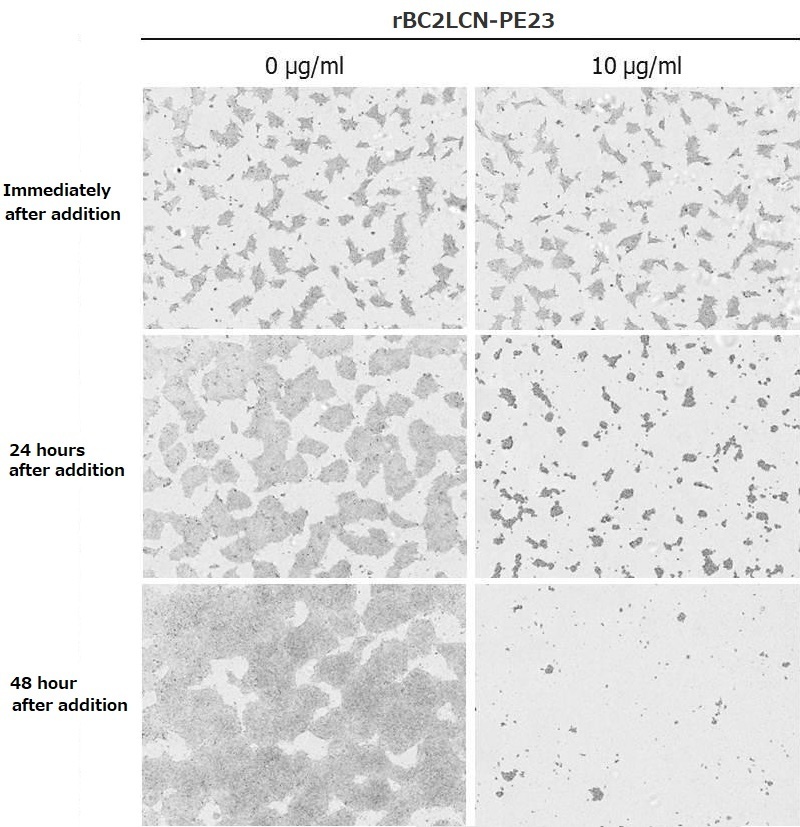
rBC2LCN (AiLecS1) is a recombinant lectin produced by expressing the N-terminal domain of BC2L-C, a lectin derived from Burkholderia cenocepacia, in Escherichia coli. rBC2LCN has very high specificity to sugar chains which exists on the cell surfaces of undifferentiated human ES cells and human iPS cells(hPSCs).
This product is a recombinant lectin-toxin fusion protein produced by fusing the catalytic domain (PE23) of endotoxin derived from Pseudomonas aeruginosa to the C-terminal of rBC2LCN. When rBC2LCN-PE23 internalized into hPSCs, it induces cell death by inhibiting protein synthesis. Since the dead cells will float in the culture vessel, they can be removed just by media change.
By using of this product, it is anticipated to improve the safety of regenerative medicine using hPSCs.
Features
- Can selectively remove undifferentiated hPSCs
- Can remove hPSCs only by adding to the culture media withoutcell dispersion
- Applicable for cell sheets and large quantities of cells
Product outline
- Sterility testing passed (filtration sterilization performed with a 0.22 μm filter)
- 0.1 x PBS (-) solution
Instructions for use
- Prepare cells differentiated from hPSCs
- Add rBC2LCN-PE23 to the culture media to the final concentration of 10 μg/ml (the concentration of rBC2LCN-PE23 is indicated on the product label)
- Incubate at 37°C with 5% CO2 (set the time when remaining undifferentiated cells can be removed by observing the cells)
- Continue culturing the differentiated cells in a suitable medium.
Removal of human ES / iPS cells
Removal of human iPS cells
rBC2LCN-PE23 was added to culture media containing human iPS cell 201B7 strain at final concentrations of 1 and 10 μg/ml. After 24 hours, cytoplasm of live cells and nucleus of dead cells were stained green and red, respectively. In culture media without rBC2LCN-PE23 (0 μg/ml), almost all of the human iPS cells were attached to the culture vessel and stained green, indicating they were still viable. However, in culture media containing 10 μg/ml of rBC2LCN-PE23, almost no attached cells, most human iPS cells floated and were removed by media change.
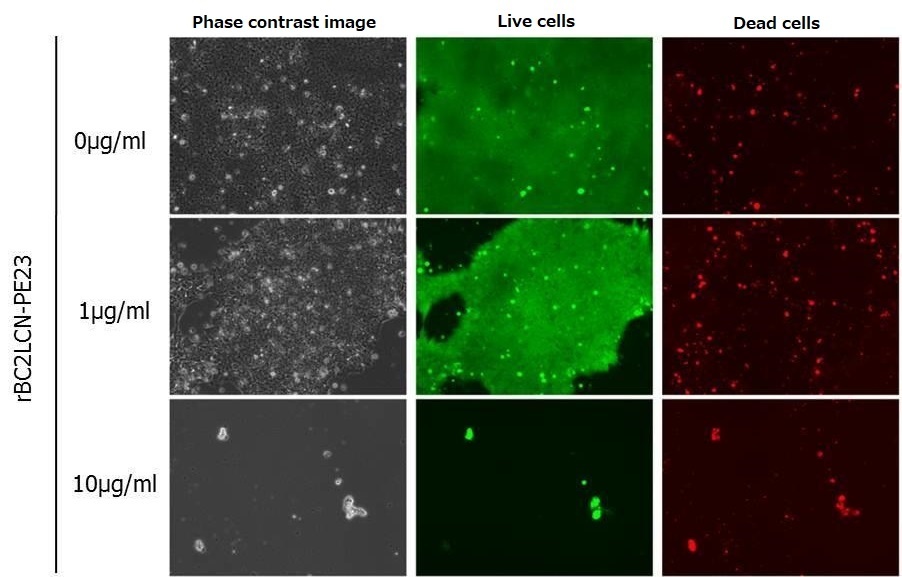
<Data provided by Dr. Hiroaki Tateno of the Biotechnology Research Institute for Drug Discovery, National Institute of Advanced Industrial Science and Technology>
Removal of human ES cells
rBC2LCN-PE23 was added to culture media containing human ES cell WA01 strain at a final concentration of 10 μg/ml. After 0, 6 and 24 hours, the cytoplasm of live cells and nucleus of dead cells were stained green and red, respectively. Before addition of rBC2LCN-PE23, almost all human ES cells were attached to the culture vessel and stained green, indicating they were viable. Cells treated with 10 μg/ml of rBC2LCN-PE23 for 6 hours showed morphological changes and the number of dead cells staining red increased. Cells treated for 24 hours, most human ES cells floated and were removed by media change.
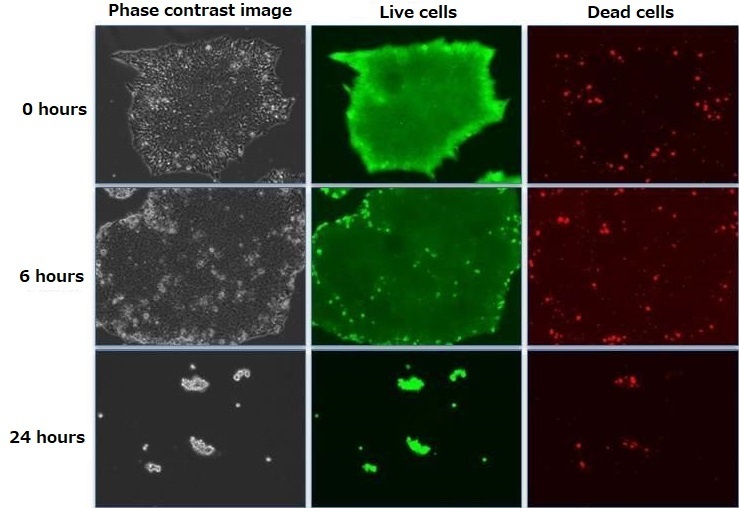
<Data provided by Drs. Yasuko Onuma and Yuzuru Ito, Stem Cell Engineering Research Group, Biotechnology Research Institute for Drug Discovery, National Institute of Advanced Industrial Science and Technology>
Selective removal of human ES / iPS cells
A mixture containing human iPS cell 201B7 strain and human fibroblasts was cultured for two days. rBC2LCN-PE23 was then added to the culture media at a final concentration of 10 μg/ml. After 24 hours, it was found that human iPS cells were selectively killed and dead cells floated and were removed by media change. A mixture containing human ES cell WA01 strain and human fibroblasts was also cultured in the same manner. After the resulting culture media was treated with rBC2LCN-PE23 for 24 hours, it was also found that human ES cells were selectively killed and dead cells floated and were removed by media change.
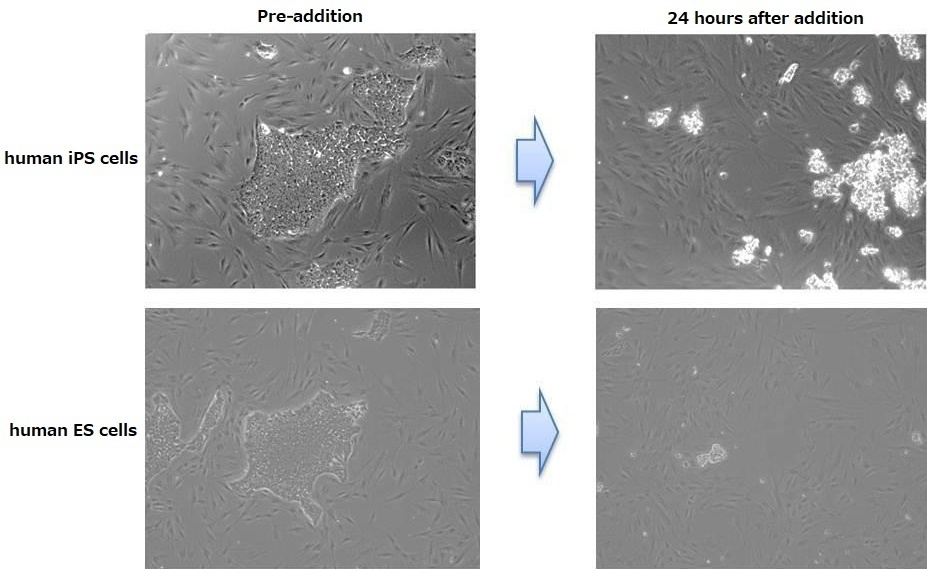
<Data provided by Drs. Yasuko Onuma and Yuzuru Ito, Stem Cell Engineering Research Group, Biotechnology Research Institute for Drug Discovery, National Institute of Advanced Industrial Science and Technology>
Effects on normal dermal human fibroblasts
rBC2LCN-PE23 was added to culture media containing human iPS cell 201B7 strain at a final concentration of 10 μg/ml and also to culture media containing normal human dermal fibroblasts (NHDF) at final concentrations of 5, 10, 20, 30 and 50 μg/ml. Cells counts were then performed after 48 hours. It was subsequently found that most human iPS cells had been killed and removed, with nearly no viable cells remaining. However, almost no dead NHDF were observed even when rBC2LCN-PE23 was added. It was found that rBC2LCN-PE23 had no ability to kill NHDF (the relative cell number at 0 μg/ml of rBC2LCN-PE23 was designated as 1).

Removal of human iPS cells during differentiation into mesenchymal stem cells
A culture media containing a mixture of human iPS cells and mesenchymal stem cells(MSC) produced through differentiation of human iPS cells derived from ill patients was prepared. rBC2LCN-PE23 was added to this media at a final concentration of 10 μg/ml. After 24 hours, signs of iPS cell death and colony removal began to appear. Moreover, after 48 hours, most human iPS cells were removed. However, MSC were unaffected by rBC2LCN-PE23 after 48 hours and continued to survive. Therefore, it was determined that rBC2LCN-PE23 is nonlethal to MSC.
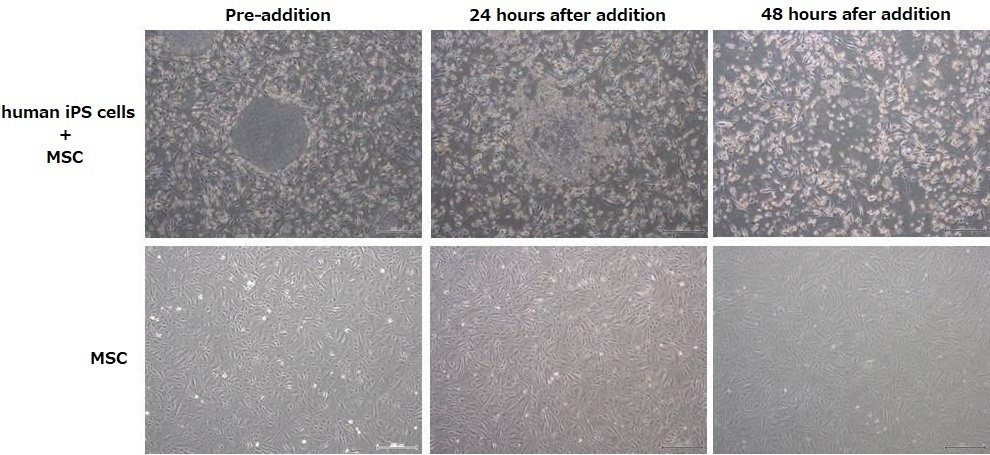
<Data provided by Dr. Hirotaka James Okano, Laboratory of Regenerative Medicine, Jikei University School of Medicine>
References
- Tateno, H., Onuma, Y., Ito Y, Minoshima, F., Saito, S., Shimizu, M., Aiki, Y., Asashima, M. and Hirabayashi.: Stem Cell Reports., 4, 811, (2015).
- Masuda, S., Miyagawa, S., Fukushima, S., Sougawa, N., Okimoto, K., Tada, C., Saito, A. and Sawa, Y.: Protein Cell, 6, 469 (2015).
Product List
- Open All
- Close All
For research use or further manufacturing use only. Not for use in diagnostic procedures.
Product content may differ from the actual image due to minor specification changes etc.
If the revision of product standards and packaging standards has been made, there is a case where the actual product specifications and images are different.
The prices are list prices in Japan.Please contact your local distributor for your retail price in your region.



